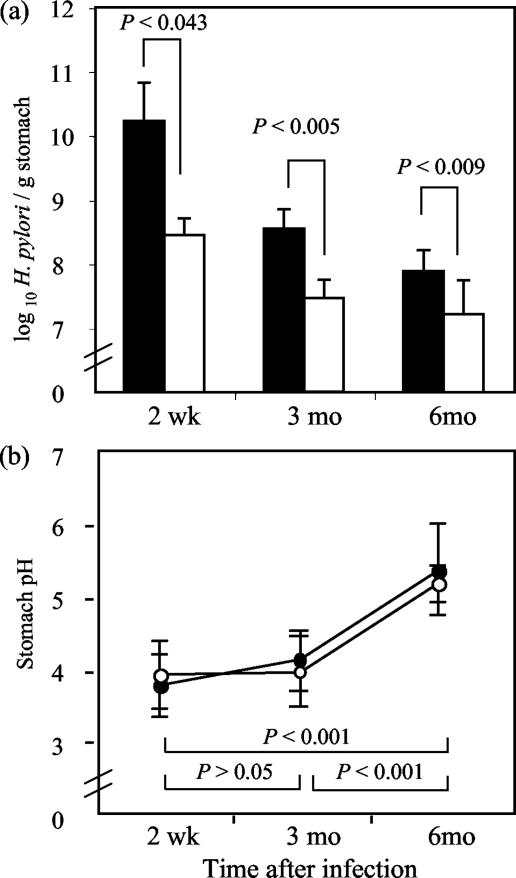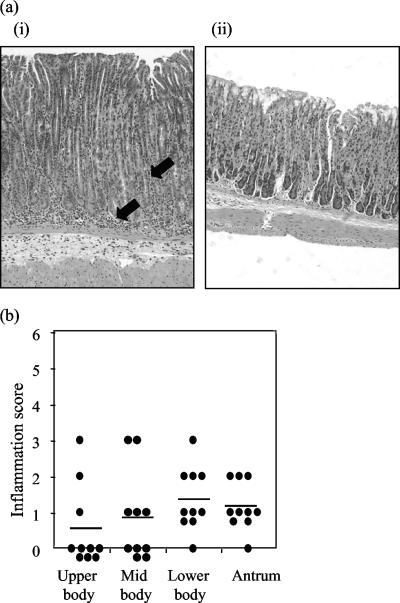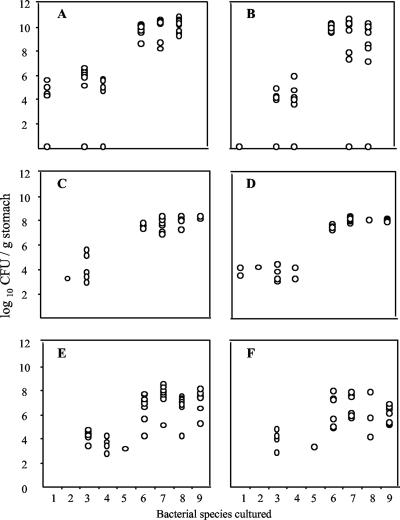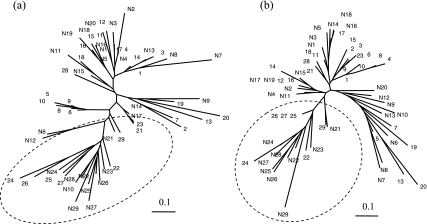Abstract
We examined the impact of Helicobacter pylori infection on the murine gastric microbiota by culture and terminal-restriction fragment length polymorphism and found that neither acute nor chronic H. pylori infection substantially affected the gastric microbial composition. Interestingly, the total H. pylori burden detected by real-time PCR was significantly higher than that revealed by viable counts, suggesting that the antigenic load sustaining H. pylori-induced gastritis could be considerably higher than previously believed.
Helicobacter pylori colonizes the stomachs of an estimated 50% of the world's population and is classified as a group 1 carcinogen (4, 15). Various animal models are currently used to study the pathogenesis of H. pylori infection, but there is little information on the gastric bacterial composition of rodents after H. pylori infection (1, 2, 7, 12). We therefore compared the gastric flora compositions, over time, of uninfected mice and of mice infected with H. pylori using conventional culture methods and terminal-restriction fragment length polymorphism (T-RFLP) analysis.
Six- to 8-week-old female C57BL/6 mice were reared under specific-pathogen-free conditions at the animal facility of the Department of Microbiology and Immunology, University of Melbourne. All animal experiments were approved by the University of Melbourne Animal Ethics and Experimental Committee and complied with relevant legislation. Statistical significance was assessed by the nonparametric Mann-Whitney U test, and two-tailed P values of less than 0.05 were considered statistically significant.
Preliminary results from culture of stomach homogenates and generation of 16S rRNA gene clone libraries from naïve mice confirmed that the murine stomach was highly colonized by lactobacilli, with the dominant species being Lactobacillus reuteri and Lactobacillus murinus (supplementary data), which is consistent with other studies (1, 2, 10, 12). In addition, T-RFLP data from an initial short-term H. pylori infection experiment with the SS1 strain (6) indicated that the gastric microbiotas of H. pylori-infected mice were similar to those of age-matched naïve mice, implying that an acute H. pylori infection does not significantly affect the gastric microbiota (supplementary data). Based on these results, we sought to study the effects of progressive H. pylori infection by infecting mice with H. pylori and examining their microbiotas at 2 weeks and 3 and 6 months after infection (9 or 10 mice per group) by T-RFLP analysis and culture. In vitro growth conditions of H. pylori were as previously described (5); mice were also infected and H. pylori organisms from mouse stomachs were quantified by culture as previously described (5). Gastric H. pylori loads were also assessed by H. pylori-specific real-time quantitative PCR (QPCR), where H. pylori-specific primers (Hp547f, 5′-CTTAACCATAGAACTGCATTTGAAACTAC-3′; Hp665r, 5′-GGTCGCCTTCGCAATGAGTA-3′ [Geneworks Pty. Ltd., SA, Australia]) and 6-carboxyfluorescein (FAM)-labeled TaqMan MGB probe (Hp597p, 5′-TACCTCTCCCACACTCT-3′ [Applied Biosystems, CA]) were designed using the Primer Express software (Applied Biosystems) based on the published H. pylori SS1 16S rRNA gene sequence (GenBank accession no. AY456638), using QPCR conditions described elsewhere (9). As the H. pylori genome contains two copies of the 16S rRNA gene, the number of 16S rRNA genes detected by QPCR was halved to estimate the number of H. pylori genomes. All infected mice were colonized with H. pylori throughout the experiment, with levels of viable bacteria being comparable with those in other studies using the same mouse infection model (3, 6, 14), but the levels of H. pylori detected by QPCR was 5- to 60-fold higher than those detected by culture (Fig. 1a). The pH of surface gastric mucosal tissue was measured by gently pressing pH strips (Sigma, St. Louis, MO) on intact exposed mucosa and was performed to determine whether any observed change in gastric flora upon H. pylori infection was due partly to alterations in the stomach acidity, especially in chronic infections. Although gastric pH increased significantly from 2 weeks to 6 months in both infected and naïve mice, the pHs were not statistically different between the groups at any time (Fig. 1b). Mice infected for 6 months were also assessed for stomach inflammation by histology as described previously (5, 13), because infiltrating immune cells and damage to the gastric mucosal epithelium could affect the numbers and types of bacteria able to proliferate in the stomach with the existing H. pylori infection. Our results indicated that all infected mice had developed a lymphocytic infiltrate and showed inflammation in at least one region of the stomach examined but that none of the naïve mice developed gastritis (Fig. 2).
FIG. 1.
H. pylori colonization and stomach pH over time. (a) H. pylori colonization was detected by real-time QPCR (filled bars) and culture (open bars) at 2 weeks, 3 months, and 6 months after infection. The means ± standard deviations from groups of 9 to 10 mice are presented. (b) Stomach pHs of infected and naïve mice. Shown here are the mean values ± standard deviations for 9 to 10 infected (•) and naïve (○) mice.
FIG. 2.
Histological examination of inflammation in the stomach. Stomach sections from mice infected for 6 months with H. pylori were stained with hematoxylin and eosin and analyzed for pathology (13). (a) Representative hematoxylin- and eosin-stained sections from infected (i) and uninfected (ii) mouse stomachs. Arrows indicate lymphocyte infiltration. (b) Summary of inflammation scores from various stomach regions of H. pylori-infected mice. Stomachs from uninfected mice revealed no inflammation. The horizontal bars indicate the mean scores.
We then examined the gastric microbiotas of these mice by T-RFLP analysis and culture, where serially diluted stomach homogenates were plated on blood agar and incubated microaerophilically for 48 h. Culture results again confirmed the predominance of lactobacilli and indicated that the compositions of culturable bacteria in mice infected with H. pylori and in naïve mice appeared to be similar at all time points (Fig. 3). T-RFLP analyses were performed as described previously (11), with slight modifications. Two separate T-RFLP analyses were performed to reduce the likelihood of different bacterial species yielding the same T-RF size. A double digest using DraI and HhaI (Promega, WI) allowed us to discriminate between the Lactobacillus species detected in our preliminary studies, and the second analysis used HaeIII (Promega). Dendrograms generated from the resulting matrices using PHYLIP (Phylogeny Inference Package; University of Washington) and TreeView PPC (University of Glasgow, United Kingdom) software packages revealed an apparent cluster of animals in the 6-month group that were age but not infection status related (Fig. 4). In comparison, infected and naïve mice from the earlier time points (2 weeks and 3 months) did not exhibit any obvious clustering.
FIG. 3.
Microbiotas cultured from the stomachs of mice with (A, C, and D) and without (B, D, and F) persistent H. pylori infection at 2 weeks (A and B), 3 months (C and D), and 6 months (E and F). Bacterial species identified by culture were as follows: column 1, Escherichia coli; column 2, Moraxella osloensis; column 3, Actinobacillus muris; column 4, Pasteurella sp.; column 5, Enterococcus faecalis; column 6, Lactobacillus murinus; column 7, Lactobacillus reuteri; column 8, Lactobacillus gasseri; and column 10, Lactobacillus intestinalis.
FIG. 4.
Dendrograms generated from T-RFLP analyses using (a) a DraI/HhaI double digest or (b) a HaeIII digest of FAM-labeled PCR products. Scale bars indicate a 10% difference between individual samples. Numbers: 1 to 10, mice infected for 2 weeks; 11 to 19, mice infected for 3 months; 20 to 29, mice infected for 6 months; N1 to N10, naïve mice in the 2-week group; N11 to N20, naïve mice in the 3-month group; N21 to N29, naïve mice in the 6-month group. Dashed ovals indicate the apparent clustering of mice from the 6-month group.
Our results suggested that neither acute nor chronic H. pylori infection appeared to alter the murine gastric microbial composition, contrary to findings of previous studies (1, 8). Neither culture nor T-RFLP analyses indicated any distinct differences between infected and uninfected mice. Rather, statistical analysis of the mean Sorensen's distances and diversity indices (Shannon's and Simpson's) using T-RFLP data showed that the mice infected for 6 months were similar to the age-matched naïve mice (data not shown). Hence, the bacterial community composition was not dramatically affected by the persistent colonization of H. pylori in the stomach and H. pylori-induced inflammation in the gastric mucosa seen in chronically infected mice or by the apparent age-dependent decrease in stomach acidity. It should be noted, however, that more-extensive H. pylori-induced damage to the mucosa (e.g., atrophy and metaplasia) might have occurred had the infection progressed further (6). Lastly, lymphocytes (predominantly T cells) infiltrating the gastric mucosa during chronic H. pylori infection are presumed to be specific for viable H. pylori. However, the QPCR data reported here showed that a high proportion of the H. pylori organisms present in mouse stomachs are in fact nonculturable, suggesting an underestimation of available bacterial antigens contributing to H. pylori-induced gastritis.
In summary, we have shown that neither acute nor chronic H. pylori infection appeared to affect the gastric microbial composition in mice despite changes in the stomach pH and Helicobacter-induced inflammation. Animal studies often aim to model human disease, and unlike with mice, the human stomach is poorly colonized by microorganisms. Therefore, it is interesting that the murine gastric microbiota, consisting largely of lactobacilli, appears to be independent of H. pylori infection status. This finding may prove important to studies examining the probiotic effects of lactobacillus strains present in a normal mouse stomach.
Supplementary Material
Acknowledgments
This work was financially supported by the Australian Government's Cooperative Research Center Program and the NHMRC.
We thank Angelo Zaia (Microbiological Diagnostic Unit, University of Melbourne) for his advice during the designing of the QPCR primers and probe and Melinda Ziino (Melbourne Genotyping Division, Australian Genome Research Facility) for processing T-RFLP samples.
Footnotes
Published ahead of print on 1 December 2006.
Supplemental material for this article may be found at http://aem.asm.org/.
REFERENCES
- 1.Aebischer, T., A. Fischer, A. Walduck, C. Schlotelburg, M. Lindig, S. Schreiber, T. F. Meyer, S. Bereswill, and U. B. Gobel. 2006. Vaccination prevents Helicobacter pylori-induced alterations of the gastric flora in mice. FEMS Immunol. Med. Microbiol. 46:221-229. [DOI] [PubMed] [Google Scholar]
- 2.Brown, J. F., and E. Balish. 1978. Gastrointestinal microecology of BALB/c nude mice. Appl. Environ. Microbiol. 36:144-159. [DOI] [PMC free article] [PubMed] [Google Scholar]
- 3.Ferrero, R. L., J.-M. Thiberge, M. Huerre, and A. Labigne. 1998. Immune responses of specific-pathogen-free mice to chronic Helicobacter pylori (strain SS1) infection. Infect. Immun. 66:1349-1355. [DOI] [PMC free article] [PubMed] [Google Scholar]
- 4.IARC. 1994. Schistosomes, liver flukes and Helicobacter pylori. IARC Monogr. Eval. Carcinog. Risks Hum. 61:177-240. [PMC free article] [PubMed] [Google Scholar]
- 5.Kaparakis, M., K. L. Laurie, O. Wijburg, J. Pedersen, M. Pearse, I. R. van Driel, P. A. Gleeson, and R. A. Strugnell. 2006. CD4+ CD25+ regulatory T cells modulate the T-cell and antibody responses in helicobacter-infected BALB/c mice. Infect. Immun. 74:3519-3529. [DOI] [PMC free article] [PubMed] [Google Scholar]
- 6.Lee, A., J. O'Rourke, M. Corazon de Ungria, B. Robertson, G. Daskalopoulos, and M. F. Dixon. 1997. A standardized mouse model of Helicobacter pylori infection: introducing the Sydney strain. Gastroenterology 112:1386-1397. [DOI] [PubMed] [Google Scholar]
- 7.Monstein, H.-J., A. Tiveljung, C. H. Kraft, K. Borch, and J. Jonasson. 2000. Profiling of bacterial flora in gastric biopsies from patients with Helicobacter pylori-associated gastritis and histologically normal control individuals by temperature gradient gel electrophoresis and 16S rDNA sequence analysis. J. Med. Microbiol. 49:817-822. [DOI] [PubMed] [Google Scholar]
- 8.Mowat, C., C. Williams, D. Gillen, M. Hossack, D. Gilmour, A. Carswell, A. Wirz, T. Preston, and K. E. L. McColl. 2000. Omeprazole, Helicobacter pylori status, and alterations in the intragastric milieu facilitating bacterial N-nitrosation. Gastroenterology 119:339-347. [DOI] [PubMed] [Google Scholar]
- 9.Nadkarni, M. A., F. E. Martin, N. A. Jacques, and N. Hunter. 2002. Determination of bacterial load by real-time PCR using a broad-range (universal) probe and primers set. Microbiology 148:257-266. [DOI] [PubMed] [Google Scholar]
- 10.Roach, S., D. C. Savage, and G. W. Tannock. 1977. Lactobacilli isolated from the stomach of conventional mice. Appl. Environ. Microbiol. 33:1197-1203. [DOI] [PMC free article] [PubMed] [Google Scholar]
- 11.Sait, L., M. Galic, R. A. Strugnell, and P. H. Janssen. 2003. Secretory antibodies do not affect the composition of bacterial microbiota in the terminal ileum of 10-week-old mice. Appl. Environ. Microbiol. 69:2100-2109. [DOI] [PMC free article] [PubMed] [Google Scholar]
- 12.Sun, Y. Q., H. J. Monstein, L. E. Nilsson, F. Petersson, and K. Borch. 2003. Profiling and identification of Eubacteria in the stomach of Mongolian gerbils with and without Helicobacter pylori infection. Helicobacter 8:149-157. [DOI] [PubMed] [Google Scholar]
- 13.Sutton, P., S. J. Danon, M. Walker, L. J. Thompson, J. Wilson, T. Kosaka, and A. Lee. 2001. Post-immunisation gastritis and Helicobacter infection in the mouse: a long term study. Gut 49:467-473. [DOI] [PMC free article] [PubMed] [Google Scholar]
- 14.Suzuki, K.-I., Y. Kokai, N. Sawada, E. Isogai, H. Isogai, and M. Mori. 2002. SS1 Helicobacter pylori disrupts the paracellular barrier of the gastric mucosa and leads to neutrophilic gastritis in mice. Virchows Arch. 440:318-324. [DOI] [PubMed] [Google Scholar]
- 15.Taylor, D. N., and M. J. Blaser. 1991. The epidemiology of Helicobacter pylori infection. Epidemiol. Rev. 13:42-59. [DOI] [PubMed] [Google Scholar]
Associated Data
This section collects any data citations, data availability statements, or supplementary materials included in this article.






